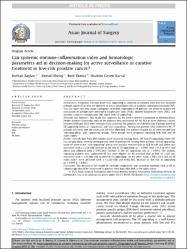| dc.contributor.author | Baylan, Burhan | |
| dc.contributor.author | Ulusoy, Kemal | |
| dc.contributor.author | Ekenci, Berk | |
| dc.contributor.author | Kartal, İbrahim Güven | |
| dc.date.accessioned | 2023-12-13T08:36:37Z | |
| dc.date.available | 2023-12-13T08:36:37Z | |
| dc.date.issued | 2023 | en_US |
| dc.identifier.citation | Baylan, B., Ulusoy, K., Ekenci, B., & Kartal, I. G. (2023). Can systemic immune-inflammation index and hematologic parameters aid in decision-making for active surveillance or curative treatment in low-risk prostate cancer?. Asian Journal of Surgery. | en_US |
| dc.identifier.uri | https://dx.doi.org/10.1016/j.asjsur.2023.11.126. | |
| dc.identifier.uri | https://hdl.handle.net/20.500.12933/1844 | |
| dc.description.abstract | Introduction: Pathologic Gleason Score (GS) upgrading is common in patients with low-risk localized prostate cancer (PCa) who are followed by active surveillance (AS) or undergo radical prostatectomy (RP). This fact raises concerns about inadequate treatment, especially in AS patients. We aimed to analyze the association of preoperative neutrophil-lymphocyte ratio (NLR), platelet-lymphocyte ratio (PLR), and systemic immune-inflammation (SII) index with GS upgrading.
Materials and methods: This study was approved by the Ethical Review Committee of Afyonkarahisar Health Sciences University. Data of the patients who underwent RP for PCa at three different centers between 2018 and 2023 were retrospectively analyzed. The patients were divided into 2 groups based on GR upgrading status as "upgrading" and "non-upgrading". Among the patients who underwent RP, 77 patients who fully met the criteria for AS were identified. The patients eligible for AS were divided into "non-upgrading" and "upgrading" groups. These groups were compared regarding NLR, PLR, and SII index values.
Results: Overall, data from 250 patients were reviewed. Among these, 147 had GS upgrading, while 103 had no upgrading. Seventy-seven patients were eligible for AS. Among these patients, 30 had upgrading, while 47 were in the "non-upgrading" group. Our analysis revealed that an NLR of 1.85 and above was associated with a 2.238-fold increase in the risk of GS upgrading (p = 0.009). Also, a PLR of 115.7 and above was affiliated with a 2.992-fold increase in the GS upgrading risk (p < 0.001). The analysis regarding patients who underwent RP but were eligible for AS revealed that an NLR of ≥1.68 was associated with a 3.25-fold risk increase in GS upgrading. On the other hand, a PLR≥134.5 and an SII index≥630.7 were affiliated with a 12.303-fold and 6.562-fold increase in the risk of upgrading (p = 0.019, p = 0.018).
Conclusion: The decision of AS should be carefully reappraised, and treatment methods such as RP or radiotherapy should be considered in patients with high NLR, PLR, or SII index values. | en_US |
| dc.language.iso | eng | en_US |
| dc.publisher | Elsevier | en_US |
| dc.relation.isversionof | 10.1016/j.asjsur.2023.11.126. | en_US |
| dc.rights | info:eu-repo/semantics/openAccess | en_US |
| dc.subject | Active Surveillance | en_US |
| dc.subject | NLR | en_US |
| dc.subject | PLR | en_US |
| dc.subject | Prostate Cancer | en_US |
| dc.subject | SII Index | en_US |
| dc.title | Can systemic immune-inflammation index and hematologic parameters aid in decision-making for active surveillance or curative treatment in low-risk prostate cancer? | en_US |
| dc.type | article | en_US |
| dc.authorid | 0000-0002-5509-7140 | en_US |
| dc.department | AFSÜ, Tıp Fakültesi, Cerrahi Tıp Bilimleri Bölümü, Üroloji Ana Bilim Dalı | en_US |
| dc.contributor.institutionauthor | Baylan, Burhan | |
| dc.contributor.institutionauthor | Ulusoy, Kemal | |
| dc.relation.journal | Asian journal of surgery | en_US |
| dc.relation.publicationcategory | Makale - Ulusal Hakemli Dergi - Kurum Öğretim Elemanı | en_US |
















